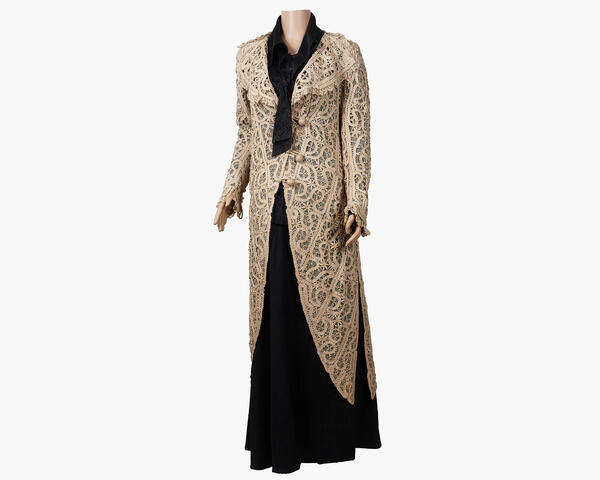A resident of Gorodets, Faina Gorokhova, donated a light lace coat to the museum in 1992. It appeared in her wardrobe thanks to a Moscow relative.
In Russia, the skill of lace-making has a centuries-old history. The word ‘lace’ was first mentioned in the 13th century Hypatian Codex to describe the princely attire of Daniel of Galicia at the meeting with the Hungarian king.
The first Russian lace was made from gold and silver threads. At that time, craftswomen already knew several different knitting techniques. Some pieces were made with a hook for connecting threads. For the other pieces, craftswomen used bobbins — wooden cylinders, where the thread was wound, with a handle. The second method allowed to knit all lace elements details at the same time.
The reforms of Peter the Great significantly influenced the development of this decorative and applied art type. In 1700, a decree was issued ordering the court nobility and officials to wear European clothes. Traditional Russian clothing — a man’s caftan with long sleeves, a woman’s sarafan hiding the shape of the body — remained to be worn by the peasants. European-style clothing was often decorated with fine lace.
There were three main techniques in Russian lace-making — numerical, multi-pair, and coupling. Numerical lace was knit without a preliminary drawing, the focus was on the number of interlacing threads. Multi-pair lace is considered the most complex — the lace pattern and the openwork background of such pieces were performed simultaneously, using a large number of bobbin pairs. This technique requires an accurate drawing called a ‘skolka’. The coupling lace also used a pattern, but it did not require so many bobbins. It got its name because separate elements were connected (‘coupled’) with the help of a simple knitting hook.
In the 1890s–1900s, summer fashion caused an increase in the number of all kinds of lace coats and light half-coats with a shortened sleeve in Russia. The magazines ‘Fashion Store’, ‘New Russian Bazaar’, ‘Fashion Light’, and ‘Ladies' World’ wrote about these items.
By the early 20th century, a summer lace coat had become an integral part of an elegant and casual women’s costume. Moreover, it was in demand among different social strata of the population — nobles, merchants, burghers. In Soviet films, there are many cases when a costume designer used the help of lacemakers. For example, in ‘An Unfinished Piece for a Mechanical Piano’, the actress Antonina Shuranova is filmed in a lace coat, and in the historical film ‘Leo Tolstoy’, the heroine of Tamara Makarova goes for a walk in a summer lace ‘trois-quarts’ — a coat with a shortened sleeve.
In Russia, the skill of lace-making has a centuries-old history. The word ‘lace’ was first mentioned in the 13th century Hypatian Codex to describe the princely attire of Daniel of Galicia at the meeting with the Hungarian king.
The first Russian lace was made from gold and silver threads. At that time, craftswomen already knew several different knitting techniques. Some pieces were made with a hook for connecting threads. For the other pieces, craftswomen used bobbins — wooden cylinders, where the thread was wound, with a handle. The second method allowed to knit all lace elements details at the same time.
The reforms of Peter the Great significantly influenced the development of this decorative and applied art type. In 1700, a decree was issued ordering the court nobility and officials to wear European clothes. Traditional Russian clothing — a man’s caftan with long sleeves, a woman’s sarafan hiding the shape of the body — remained to be worn by the peasants. European-style clothing was often decorated with fine lace.
There were three main techniques in Russian lace-making — numerical, multi-pair, and coupling. Numerical lace was knit without a preliminary drawing, the focus was on the number of interlacing threads. Multi-pair lace is considered the most complex — the lace pattern and the openwork background of such pieces were performed simultaneously, using a large number of bobbin pairs. This technique requires an accurate drawing called a ‘skolka’. The coupling lace also used a pattern, but it did not require so many bobbins. It got its name because separate elements were connected (‘coupled’) with the help of a simple knitting hook.
In the 1890s–1900s, summer fashion caused an increase in the number of all kinds of lace coats and light half-coats with a shortened sleeve in Russia. The magazines ‘Fashion Store’, ‘New Russian Bazaar’, ‘Fashion Light’, and ‘Ladies' World’ wrote about these items.
By the early 20th century, a summer lace coat had become an integral part of an elegant and casual women’s costume. Moreover, it was in demand among different social strata of the population — nobles, merchants, burghers. In Soviet films, there are many cases when a costume designer used the help of lacemakers. For example, in ‘An Unfinished Piece for a Mechanical Piano’, the actress Antonina Shuranova is filmed in a lace coat, and in the historical film ‘Leo Tolstoy’, the heroine of Tamara Makarova goes for a walk in a summer lace ‘trois-quarts’ — a coat with a shortened sleeve.



